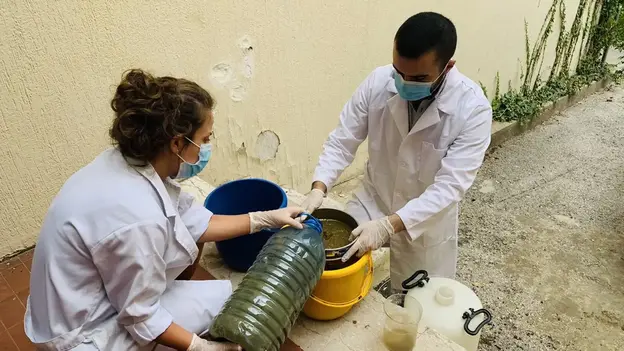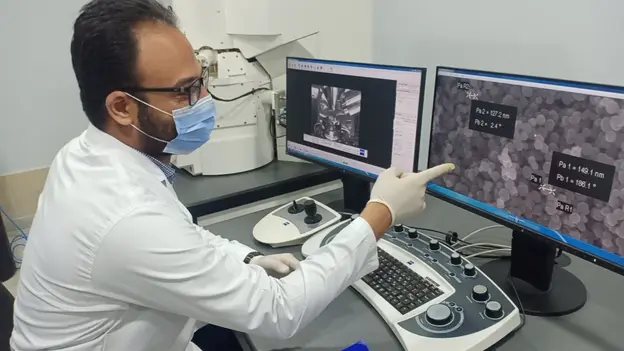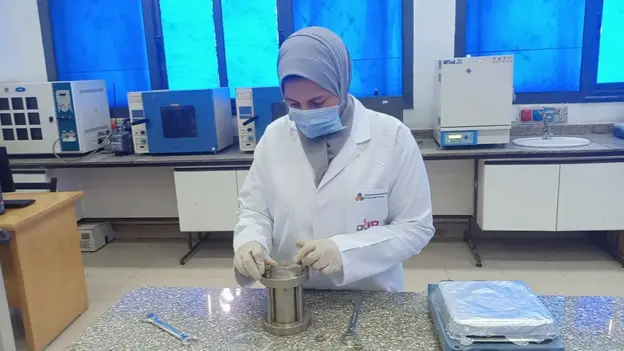Working Group Project
From Waste to Energy: Transforming Agricultural Waste
Laboratory Study
With the global energy crisis currently looming and petroleum as well as natural-gas reserves depleted, many rural areas in Egypt and Lebanon are suffering from shortages of necessary fuel for their basic daily life activities. This energy scarcity motivates applied research to find alternative sources for fuel. In this regard, biogas is considered a sustainable and effective renewable energy source that can be used to provide rural areas with the amount of much needed fuel. Biogas is the mixture of gases produced by the breakdown of organic matter in the absence of oxygen (anaerobically), primarily consisting of methane and carbon dioxide. Biogas can be produced from anaerobic digestion of raw materials such as agricultural waste, manure, municipal waste, plant material, sewage, green waste or food waste. One of the main benefits is that the digestate remaining after the biogas production can be used as an excellent fertilizer for agricultural activities.
Enhancing biogas production
Despite the fact that some Arab governments have started to invest in small-scale biogas production, the restrictive bottlenecks are both the production costs as well as the production efficiency. Therefore, the AGYA Working Group ‘Energy, Water and Environment’ proposes a unique and innovative approach to tackle these challenges. In the proposed project, the involved AGYA members aim to investigate the effect of nanoadditives to enhance the biogas production efficiency and reduce the costs. Specifically, they suggest to use biocompatible nanoadditives to avoid negative effects of nanomaterials on fermentation bacteria and thus on the biogas production.
In addition, AGYA members Prof. Dr. Zeina Hobeika (Biochemistry), Prof. Dr. Ahmed Khalil (Materials Sciences) and Prof. Dr. Nageh Allam (Physics; Materials Sciences) propose combining solar energy with biogas production plants to enhance the production rate. This is achieved by modelling simulations to determine the most promising combinations of agricultural waste and nanoadditives to achieve the highest possible rate of biogas production. The experimental research is conducted at the American University in Cairo (Egypt) and the University of St Joseph (Lebanon) in close cooperation with Fayoum University (Egypt).
Nanoadditives, increased methane production, and optimal biogas mixtures
In a first step, nanoadditives including TiO2 nanoparticles, ferrite nanoparticles, and carbon ash were fabricated and fully characterized using different techniques. The effect of selected materials and elements in relation to the biogas production has been studied. The project partner at the University of St Joseph began with cooper (Cu). They have conducted the anaerobic digestion of vinicultural waste in presence of different Cu concentrations. The obtained results are very promising. In fact, grape waste can be considered as a highly usable bioenergy source. The addition of Cu increased the methane production, thus optimizing the process.
Another result refers to the analysis of biogas combustion characteristic. The project partners at the American University Cairo conducted a study of biogas combustion under partially premixed mode to investigate the stability of biogas free-jet flames using a concentric flow slot burner. Five mixtures of biogas ranging from 0% CO2 to 40% CO2 were investigated to study the effect of CO2 proportion on the stability of biogas flames.
- Disciplines Involved
- Biochemistry, Engineering, Materials Science
- Cooperation Partners
- American University Cairo, Egypt
- University of St Joseph, Lebanon
- Fayoum University, Egypt
- Project Title
- From Waste to Energy: Conversion of Agricultural Waste to Value-Added Fuel
- Year
- 2020
- Funding Scheme
- Working Group Project
- Working Group
- Energy, Water and Environment
- Countries Involved
- Egypt, Germany, Lebanon
- AGYA Publication
- Mapping the Stability of Free-Jet Biogas Flames under Partially Premixed Combustion








